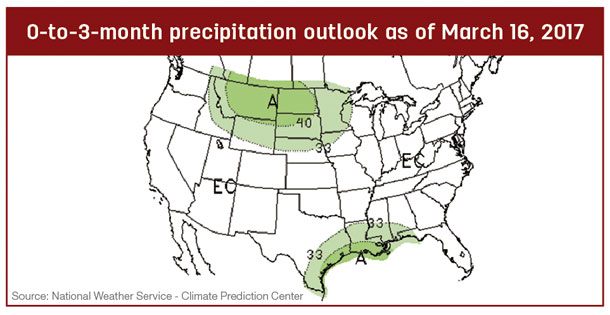The U.S. Drought Monitor (March 23, 2017) rates a large portion of the south-central and southeastern regions between abnormally dry and severe drought with some pockets of extreme drought. The recent three-month seasonal drought outlook (March 16, 2017) suggests improvement in some areas but persisting and worsening conditions in other areas through June.

For much of this region, April, May and June are important because a significant portion of the annual precipitation occurs in these months.
With the potential for drier conditions in some of the region this year, here are some basics to consider:
- Monitor rainfall. If not already, become familiar with seasonal rainfall patterns during the forage production year. Timing of rainfall can be as important as how much rainfall occurred during the year. Track precipitation during the growing season to identify when deficits or surpluses are accumulating.
- Monitor ground cover and forage utilization. Although rainfall is a key factor, others can affect forage production. Maintaining adequate ground cover (litter and standing forage) helps capture and retain moisture from precipitation and contributes to the effectiveness of rainfall.
Additionally, maintaining adequate leaf area during the growing season allows the plants to respond more rapidly to rainfall. Finally, production systems that rely on standing forage throughout the year must accumulate a surplus of forage to carry into the dormant season. Monitor production and utilization, and be ready to adjust stocking pressure during the growing season.
- Plan management strategies to adjust to conditions. Managing stocking pressure is the primary means of adjusting to rainfall and growing conditions. Develop a destocking plan that can be implemented in stages as conditions require.
An objective is to identify and maintain a core group of cows in their prime years for calf production. Any cattle not in this group are candidates for moving out when adjusting stocking pressure.
Running budget projections for contingencies, inventorying other feed resources, locating other grazing, planning marketing for forced sales and other aspects, should be addressed in the planning process.
• Identify dates to make key decisions and dates to implement adjustment strategies. Mark it on the calendar and implement the steps if conditions require action. ![]()

-
F.T. McCollum III
- Beef Cattle Production Specialist
- Texas A&M AgriLife Extension Service
- Email F.T. McCollum III








